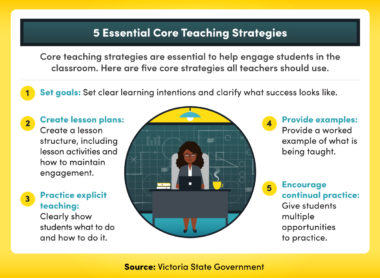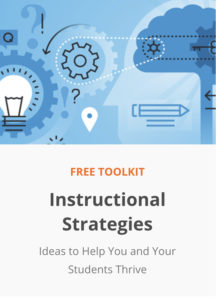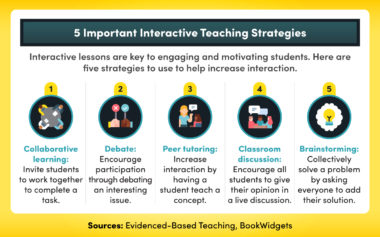17 Teaching Strategies for Boosting Student Engagement

This famous quote sums up exactly why effective teaching strategies are so important:
“Tell me and I forget. Teach me and I remember. Involve me and I learn.”
When it comes to student learning, teaching strategies can be the difference between a great learning experience and not learning anything at all. In the past, students passively took notes while the teacher delivered a theory-based lecture. Nowadays, specific teaching strategies—including encouraging students to set goals, explore worked examples, and interact with the content, the teacher, and each other—are shown to be more effective in ensuring students are motivated and engaged in their learning.
This article will explore 17 different strategies that teachers can use to better engage students. These teaching strategies will be divided into four categories: core teaching strategies, high-impact teaching strategies, interactive teaching strategies, and literacy teaching strategies. Each strategy description will include information on how teachers can use the strategy to best interact with students and increase their engagement.
Core Teaching Strategies
 Core teaching strategies should be included in every lesson as much as possible. As they are the fundamentals of an effective lesson and help students engage from the very beginning. Here are five examples of core teaching strategies.
Core teaching strategies should be included in every lesson as much as possible. As they are the fundamentals of an effective lesson and help students engage from the very beginning. Here are five examples of core teaching strategies.
Strategy 1: Setting Goals
One core teaching strategy that is essential in each and every lesson is setting goals. Setting goals for a lesson helps increase student engagement as it enables students to understand the learning intentions of the lesson and provides a clear path to success. Working backwards from the goals also enable the teacher to plan relevant activities.
To boost student engagement when setting goals, teachers should aim to:
- Create goals based on student needs (ideally those previously assessed).
- Present goals clearly to students and make them actionable.
- Focus on both surface and deep learning.
- Challenge students relative to their current competency levels.
- Link goals to explicit and attainable assessment criteria.
Strategy 2: Create Learning Plans
Another core teaching strategy for student engagement is creating learning plans. Learning plans provide a structure for the teaching and learning that occur in class and reinforce how that learning will take place. Learning plans are also important in providing a solid structure for how much time should be spent on certain tasks, allowing for appropriate transitions between tasks.
Providing students with this type of structure increases engagement as it links the lesson outcomes with the learning that takes place (and subsequently with the activities that underpin that learning).
To boost student engagement when creating learning plans, teachers should:
- Set clear expectations at the beginning.
- Sequence and link learning activities.
- Include clear instructions and transitions between activities.
- Detail any questioning and feedback that needs to take place.
- Provide formative assessment.
Strategy 3: Explicit Teaching
Students need far more than passively delivered theory to learn. They need to be clearly shown what to do and how to do it, and that is what the core teaching strategy of explicit teaching provides.
To practice explicit teaching, a teacher first decides on a set of learning intentions and success criteria. Then, the teacher clearly explains these to students and demonstrates them through modelling. Finally, the teacher checks that students understand what has been taught by revisiting it at the end of the lesson and tying everything together.
To boost student engagement through explicit teaching, teachers should:
- Clearly share learning intentions.
- Create relevant content and activities.
- Explicitly introduce new content.
- Model knowledge and skills.
- Include worked examples to support independent learning.
- Practice feedback loops to address misunderstanding.
Strategy 4: Providing Examples
The fourth core teaching strategy essential for boosting student engagement is providing examples (also known as worked examples). When providing examples, teachers demonstrate the steps required to complete a task or solve a problem.
By providing examples, teachers help support skill acquisition as students can see, in real life, how a problem is solved (this, in turn, reduces the learner’s cognitive load). When later attempting to solve problems themselves, students can use examples to understand how they can apply the learning to their own work.
To boost student engagement through providing worked examples, teachers should:
- Clarify the learning objective of the exercise.
- Actively demonstrate to students what is required to acquire new skills.
- Present every step in solving the problem.
- Enable students to practice independently, while still having access to the worked example.
Strategy 5: Continual Practice
The final core teaching strategy is encouraging continual practice. As the name suggests, continual practice is where students are given multiple opportunities to encounter, engage with, and then elaborate on what they have learnt.
Oftentimes, students can’t learn a new skill if they have only been exposed to it once. With continual practice, though, they are more likely to acquire the skill as they have had multiple opportunities to interact with the knowledge and concepts and use them in different ways.
To boost student engagement through continual practice, teachers should:
- Give students adequate time to practice what they have learnt.
- Expose students to what is being taught in many different ways and through multiple interactions.
- Give timely feedback to students.
- Monitor whether improvement is being made.
Further Resources
To learn more about core teaching strategies that boost student engagement, please refer to the resources below.
- The Conversation, “Explainer: What Is Explicit Instruction and How Does It Help Children Learn?”
- ClickView, “What Are Worked Examples?”
- Classcraft, “How to Create a Learning Plan”
High-Impact Teaching Strategies
 In the classroom, every teacher aims to have the highest possible impact. For that reason, high-impact teaching strategies are required to ensure that teachers can contribute effectively to student learning and boost student engagement.
In the classroom, every teacher aims to have the highest possible impact. For that reason, high-impact teaching strategies are required to ensure that teachers can contribute effectively to student learning and boost student engagement.
High-impact teaching strategies may not be appropriate for every lesson but should be used as much as possible to ensure that students can get the most out of their lessons.
Strategy 6: Continual Questioning
The first high-impact teaching strategy that teachers should use regularly, in a range of contexts, is applying continual questioning. Continual questioning engages students, stimulates their curiosity, and helps them link the learning to their broader life.
This strategy also allows students to explore topics, express their opinions, disagree, and provide alternative points of view. It enables teachers to immediately gauge how well students understand the lesson, and can help teachers capture feedback on how effective their teaching has been.
To help boost student engagement through continual questioning, teachers should:
- Plan questions in advance.
- Plan questions that will help students probe, extend, revise, and reflect on the lesson.
- Use open-ended questions.
- Use questions to solicit immediate feedback.
Strategy 7: Feed
In learning, as in life, feedback is essential. This is because feedback helps inform students and their teachers of their performance relative to their goals. Once feedback is given, students can redirect their efforts so they can more effectively achieve a learning goal. Feedback also helps teachers refocus their efforts where required.
Feedback can be given in many ways. It can either be formal or informal, oral or written. It can also be formative (given during an assignment) or summative (given after an assignment). The goal of feedback is always to improve student performance.
To boost student engagement through feedback, teachers should:
- Endeavour to always provide precise, timely, and actionable task-related feedback.
- Provide regular questioning and assessment.
- Encourage students to also provide feedback on teaching and learning.
Strategy 8: Teach Metacognitive Strategies
One high-impact teaching strategy that teachers should use regularly is teaching students metacognitive strategies, which help students think critically about their own thinking.
Metacognitive strategies encourage students to become aware of how they learn. This, in turn, gives them control over their learning, as they are able to manage their own motivation and do things like plan how they approach learning tasks, evaluate their progress, and monitor their own comprehension.
To help boost student engagement through metacognitive strategies, teachers should:
- Teach and model problem-solving.
- Teach studying skills.
- Promote self-questioning and self-reflection.
- Encourage classroom discussion.
- Encourage concept mapping.
Strategy 9: Differentiated Teaching
Another high-impact teaching strategy that teachers should endeavor to practice is using differentiated teaching. Differentiated teaching is where the teacher tries to extend the knowledge of every student in the classroom, regardless of the student’s starting point.
The objective of differentiated teaching is to help each and every student progress, including those students who may be falling behind. To achieve this objective, teachers must create realistic goals for the classroom and create lesson plans that incorporate adjustments for different students and their capability levels.
To boost student engagement through differentiated teaching, teachers should:
- Use evidence-based group instruction.
- Provide preplanned, individualized interventions.
- Provide a range of supplementary and extension materials.
Further Resources
To learn more about high-impact teaching strategies that boost student engagement, please review the resources below.
- NSW Government — Education, “Strategies for Differentiation”
- Australian Institute for Teaching and School Leadership, “Questioning: What Is It?”
Interactive Teaching Strategies
 Interaction in teaching is not just considered a nice-to-have but is instead a need-to-have. Interactive teaching strategies help to boost motivation and engagement in the classroom and make teaching and learning more enjoyable.
Interaction in teaching is not just considered a nice-to-have but is instead a need-to-have. Interactive teaching strategies help to boost motivation and engagement in the classroom and make teaching and learning more enjoyable.
Interaction can also have a whole host of other benefits, from increasing competition in the classroom to adding tiers of achievement and helping students use their imagination. Here are five interactive teaching strategies.
Strategy 10: Collaborative Learning
The first interactive teaching strategy that is important in the classroom is implementing collaborative learning. Collaborative learning is where students work together in groups (or as an entire class) to solve a problem or complete a task.
Collaborative learning can be facilitated in the classroom in many ways. Typically, students who participate have different roles and responsibilities, so they will naturally need to work together to achieve certain outcomes.
To boost student engagement through collaborative learning, teachers should:
- Help students work together to apply knowledge and skills they already have.
- Facilitate cooperation between students.
- Enable students to compete against each other, if appropriate.
- Group students together in a way that fosters peer learning.
Strategy 11: Debate
Another effective interactive teaching strategy is setting up a debate. Debates are where two (or multiple) students argue a particular point of view. A debate can have a winner, although it is not necessary.
Engaging students in a debate is effective, as it encourages them to create their own understanding of a topic and argue in favour of a particular point. Students will naturally connect more deeply and gain broader insight into the topic through understanding different perspectives.
To boost student engagement through debate, teachers should:
- Encourage students to take on different roles, such as debater or moderator roles.
- Include questions that will inspire a rigorous conversation.
- Provide students with time to prepare.
- Give students guidance on how to ask probing questions.
Strategy 12: Peer Tutoring
When it comes to interactive teaching strategies, the teacher is not the only person who can give instruction. Using a peer tutoring strategy, other students in the classroom can effectively become the teachers.
A number of setups are available for peer tutoring. One example is where a high-achieving student teaches a concept back to the class; another is where a high-achieving student is coupled with a lower-achieving student. Either way, a student is actively involved in teaching content and helping others. This arrangement can greatly assist other students with understanding something from the perspective of someone more at their level.
To boost student engagement through peer tutoring, teachers should:
- Identify high-achieving students.
- Request that high-achieving students participate (as opposed to telling them to participate).
- Give the peer tutor the resources they need to teach the concept.
- Effectively pair high-achieving with lower-achieving students.
Strategy 13: Classroom Discussion
It may seem like the most basic interactive teaching strategy, but it can also be the best: prioritizing classroom discussion. As the name suggests, classroom discussion is where the teacher engages the entire classroom in a discussion on a given topic.
Teachers can hold discussions in a number of ways. They might choose to do so through instructional conversation, where they listen carefully and adjust their teaching according to how students are reacting throughout the conversation. Alternatively, they may choose a format such as collaborative reasoning, where students are broken into small groups and asked to manage a discussion among themselves.
To boost student engagement through classroom discussion, teachers should:
- Actively listen to students throughout the discussion.
- Use a range of teaching materials, depending on where the discussion leads.
- Break students into small groups to host their own discussions.
- Have a larger group discussion on what has been learnt.
Strategy 14: Brainstorming
The final interactive teaching strategy that teachers can use is facilitating brainstorming exercises. Brainstorming can be a large- or small-group activity where students are asked to find a solution to a particular problem.
To begin brainstorming, teachers should pose a question or define a problem but not discuss any possible solutions. Students should then be encouraged to debate among themselves and decide on a solution. Typically, one person in the group reports back to the wider group on what solution they have discovered.
To boost student engagement through brainstorming, teachers should:
- Pose one problem at a time to groups.
- Ensure that groups are not within earshot of each other, so they come up with original ideas.
- Provide no solutions or tips.
- Be positive and encouraging at all times.
Further Resources
To learn more about interactive teaching strategies that boost student engagement, please review the resources below.
- Reading Rockets, “Using Peer Tutoring to Facilitate Access”
- Center for Research on Education, Diversity & Excellence, “Instructional Conversation”
- Jacaranda, “Collaborative Learning: Tips and Strategies for Teachers”
Literacy Teaching Strategies
Underpinning almost all teaching strategies is one important facet of student education: literacy. Literacy is considered a critical skill to engage both in the classroom and everyday life. For this reason, all teachers should be familiar with effective literacy teaching strategies.
Here are three important literacy teaching strategies.
Strategy 15: Read-Alouds
Oral language is an important foundation for literacy. Long before students learn how to read, they acquire a vast vocabulary that helps them to communicate. For this reason, reading aloud is an important literacy teaching strategy.
Reading aloud to children allows them to develop their listening and speaking skills, which in turn assists in their overall language development. Students who are read to often develop a broad language base and the ability to understand stories.
To boost student engagement through read-alouds, teachers should:
- Select high-quality picture books where the images shown support the story.
- Select developmentally appropriate books.
- Choose books that extend students’ vocabularies.
- Select books that have a meaningful and engaging story.
Strategy 16: Vocabulary Instruction
Another effective literacy teaching strategy is emphasizing vocabulary instruction. Unlike other teaching strategies, which end when class finishes, mastering vocabulary is something that students need to continue to work on their whole lives.
Teachers can perform vocabulary instruction in many varied and interesting ways. They can indirectly expose students to a broad vocabulary through reading complex books to them. They also can perform more specific vocabulary instruction through explicit activities and word-learning strategies.
To boost student engagement through vocabulary instruction, teachers should:
- Read (or encourage students to read) a vast array of different books to expand their word knowledge.
- Enhance text comprehension by providing instruction on specific words.
- Provide instruction in independent word-learning strategies.
- Use word consciousness and word-play activities.
Strategy 17: Writing to Learn
The final literacy teaching strategy that teachers should use is employing writing to learn activities. Writing to learn is where teachers encourage students to reflect on what they have learnt and then write about it to expand their vocabulary.
Writing to learn activities are different from most writing activities in which the express purpose is to inform, instruct, or persuade. Generally, writing to learn activities are different in that they are short or informal and help students work through key concepts or ideas. They usually take five minutes or less to complete.
To boost student engagement through writing to learn, teachers should:
- Give students short, brief writing assignments.
- Ask them to summarize key points.
- Ask them to clarify certain topics.
- Ask students to record or reflect on their observations.
Further Resources
To learn more about literacy teaching strategies that boost student engagement, review the resources below.
- Reading Rockets, “Reading Aloud to Build Comprehension”
- 3P Learning, “Everything Teachers Need to Know About Teaching Vocabulary Effectively”
- Thoughtful Learning, “12 Writing-to-Learn Activities”
What Is the Most Effective Teaching Strategy?
In the classroom, no single teaching strategy stands out beyond the rest as the most important or effective. In reality, the needs of students in a classroom change from day to day and topic to topic. The most effective teaching strategies change alongside these needs, so the role of teachers is to understand what teaching strategies are available to them and deploy them whenever needed to achieve the best outcomes.
Originally published on Southern Cross University’s website.